Attractions · Europe · Events · Featured · Food and Drink · France · Going Out · Regions · Restaurants · Travel Miscellany · Western Europe
The most beautiful market in France
If you’ve ever explored France, chances are that you’ve stumbled upon one of the country’s many markets. These have long been a thriving tradition in France with regular markets displaying produce ranging from fruit and vegetables, to fish, meat and other delicacies, as well as many non-food stalls.
The market at Sanary-sur-Mer is no exception. There’s a market in the seaside town every day of the year except for Christmas Day, but visit on a Wednesday for the main event, from around 8am to 1pm. Last year French TV channel TF1, the most viewed television channel in Europe, pronounced it the most beautiful market in France, beating tough competition from all over the country after four months of voting.
 Situated in the department of Var, between Marseille and Toulon, Sanary-sur-Mer has a picturesque harbourside setting, and fought off tough competition from Royan (2nd), St. Pierre of Reunion (3rd), Uzès (4th), Arras (5th), Châtillon-sur-Chalaronne (6th), Issigeac (7th), Dieppe (8th), Puy-en-Velay (9th) and Valves (10th) to be crowned the most beautiful market in France.
Situated in the department of Var, between Marseille and Toulon, Sanary-sur-Mer has a picturesque harbourside setting, and fought off tough competition from Royan (2nd), St. Pierre of Reunion (3rd), Uzès (4th), Arras (5th), Châtillon-sur-Chalaronne (6th), Issigeac (7th), Dieppe (8th), Puy-en-Velay (9th) and Valves (10th) to be crowned the most beautiful market in France.
 Wednesdays are a great day for fish at the market with many stalls lining the harbour, displaying recent catches – some quite large – right by the water’s edge. Even if you have no intention of buying, it’s fun just to watch the hive of activity as fishermen cut a whole tuna into steaks ready for sale or chat to passing customers.
Wednesdays are a great day for fish at the market with many stalls lining the harbour, displaying recent catches – some quite large – right by the water’s edge. Even if you have no intention of buying, it’s fun just to watch the hive of activity as fishermen cut a whole tuna into steaks ready for sale or chat to passing customers.

 Just a stone’s throw from here, a specialist horse meat van sold a variety of different cuts. Given the anatomical similarities to a cow, these cuts are much the same as you would find in beef, but typically with less fat. Finer cuts such as tenderloin, sirloin and entrecote were all displayed, along with a number of cheaper cuts more suited to slower cooking and for use in casseroles, for example.
Just a stone’s throw from here, a specialist horse meat van sold a variety of different cuts. Given the anatomical similarities to a cow, these cuts are much the same as you would find in beef, but typically with less fat. Finer cuts such as tenderloin, sirloin and entrecote were all displayed, along with a number of cheaper cuts more suited to slower cooking and for use in casseroles, for example.
 There are also stalls cooking dishes in what I would call large paella pans but no doubt they have a different name in France!
There are also stalls cooking dishes in what I would call large paella pans but no doubt they have a different name in France!


 I visited with the owner of the new small luxury hotel Mas du Brulat, Su Stephens, and consultant chef for the hotel’s L’Olivier restaurant, Clive Dixon, who himself has worked alongside the likes of Heston Blumenthal and Pierre Koffmann, on a quest to find some of the region’s best local produce for the restaurant and some ingredients that Clive would use to prepare a meal for us later that evening.
The emphasis was on finding quality produce and creating a meal from that, rather than coming up with a dish first and then trying to source the required ingredients – a subtle but important difference that prioritises quality produce ahead of a pre-determined menu. And finding great produce at a French market is made easier because many of the stalls allow you to sample and taste their offerings, and you can also talk directly to the producers.
One of our first stops was at the cheese stall run by Nos Fromages de France.
I visited with the owner of the new small luxury hotel Mas du Brulat, Su Stephens, and consultant chef for the hotel’s L’Olivier restaurant, Clive Dixon, who himself has worked alongside the likes of Heston Blumenthal and Pierre Koffmann, on a quest to find some of the region’s best local produce for the restaurant and some ingredients that Clive would use to prepare a meal for us later that evening.
The emphasis was on finding quality produce and creating a meal from that, rather than coming up with a dish first and then trying to source the required ingredients – a subtle but important difference that prioritises quality produce ahead of a pre-determined menu. And finding great produce at a French market is made easier because many of the stalls allow you to sample and taste their offerings, and you can also talk directly to the producers.
One of our first stops was at the cheese stall run by Nos Fromages de France.
 There Clive was drawn to a mature goat’s cheese from the Savoie region of France that had the crumbly consistency of a Parmesan but with a delicious, nutty flavour.
There Clive was drawn to a mature goat’s cheese from the Savoie region of France that had the crumbly consistency of a Parmesan but with a delicious, nutty flavour.
 Next up the grocery stall run by Fred et Karin, a family business from Ollioules.
Next up the grocery stall run by Fred et Karin, a family business from Ollioules.
 There they had some particularly good tomatoes that you could taste and we ended up coming away with two different varieties that would go nicely with the goat’s cheese for a simple starter.
There they had some particularly good tomatoes that you could taste and we ended up coming away with two different varieties that would go nicely with the goat’s cheese for a simple starter.
 We had seen both white and green varieties of asparagus in abundance at a number of stalls so it was clearly something that was in season. We opted for the slightly more delicately-flavoured white asparagus to go with some fish that we’d be having for our main course.
We had seen both white and green varieties of asparagus in abundance at a number of stalls so it was clearly something that was in season. We opted for the slightly more delicately-flavoured white asparagus to go with some fish that we’d be having for our main course.
 Clive had had his eye on some Gariguette strawberries but, after we tasted the Carpentras variety which is famed for its early crop in Provence, it really was no contest. Displayed with them was a Qualisud certificate for their exceptional quality. And they really did taste amazing!
Clive had had his eye on some Gariguette strawberries but, after we tasted the Carpentras variety which is famed for its early crop in Provence, it really was no contest. Displayed with them was a Qualisud certificate for their exceptional quality. And they really did taste amazing!
 Next it was on to the fish stand belonging to Poissonnerie Pilato, the commerical division of which also already supplies the hotel’s L’Olivier restaurant.
Next it was on to the fish stand belonging to Poissonnerie Pilato, the commerical division of which also already supplies the hotel’s L’Olivier restaurant.
 Here we bought some monk fish…
Here we bought some monk fish…
 …and some red mullet.
…and some red mullet.
 Even if you have no interest in purchasing, it’s worth watching what goes on at the stall – the staff are quite entertaining and jovial, doing silly things like kissing the fish and pretending they are flying, as well as getting on with the more serious business of de-scaling and gutting anything you buy, should you wish.
Even if you have no interest in purchasing, it’s worth watching what goes on at the stall – the staff are quite entertaining and jovial, doing silly things like kissing the fish and pretending they are flying, as well as getting on with the more serious business of de-scaling and gutting anything you buy, should you wish.
 Whilst doing the rounds at the market, we also sampled some meats at Le Roi de la Bistouquette’s stall, where they had a particularly tasty Figatelli – a Corsican specialty – amongst other meats.
Whilst doing the rounds at the market, we also sampled some meats at Le Roi de la Bistouquette’s stall, where they had a particularly tasty Figatelli – a Corsican specialty – amongst other meats.
 There are plans back at the hotel to develop the cellars with an exciting and lively wine bar and many of these meats would be ideal for some lovely charcuterie plates, so this was a useful find for the future.
There are plans back at the hotel to develop the cellars with an exciting and lively wine bar and many of these meats would be ideal for some lovely charcuterie plates, so this was a useful find for the future.
 Of course, there are many other stalls at the market – not just more food stalls with things like bread, olives and much more, but also stalls with items such as clothes, kids’ toys and so on, but to my mind it’s the food at the market that’s by far the most interesting. Once we had our fill of the market (quite literally in some ways!), we headed for a patisserie to purchase a tarte tropézienne.
Of course, there are many other stalls at the market – not just more food stalls with things like bread, olives and much more, but also stalls with items such as clothes, kids’ toys and so on, but to my mind it’s the food at the market that’s by far the most interesting. Once we had our fill of the market (quite literally in some ways!), we headed for a patisserie to purchase a tarte tropézienne.
 As its name suggests, tarte tropézienne has its origins in St. Tropez but was in fact given its name by none other than the then relatively unknown Brigitte Bardot when she was in the city for the film ‘And God Created Woman’ which was largely responsible for bringing her into the public spotlight. As it’s name doesn’t suggest, it is more of a cake than a tart; it was invented by Alexandre Micka, a Polish pastry chef in St Tropez, and consists of a round brioche with pearl sugar and a sort of pastry cream and buttercream filling, with a delicate flavour of orange blossom water.
As its name suggests, tarte tropézienne has its origins in St. Tropez but was in fact given its name by none other than the then relatively unknown Brigitte Bardot when she was in the city for the film ‘And God Created Woman’ which was largely responsible for bringing her into the public spotlight. As it’s name doesn’t suggest, it is more of a cake than a tart; it was invented by Alexandre Micka, a Polish pastry chef in St Tropez, and consists of a round brioche with pearl sugar and a sort of pastry cream and buttercream filling, with a delicate flavour of orange blossom water.
 Finally, a wander around Sanary-sur-Mer’s streets, away from the hustle and bustle of the market, was a good way to get more of a feel for this pretty town. Explorer Jacques Cousteau had a home here and it was in the waters off Sanary that he developed diving equipment that is still crucial to deep-sea diving today. There’s even a museum – the Frédéric Dumas International Diving Museum – in the town, dedicated to the man who achieved a world-record deep-sea dive in 1943.
Finally, a wander around Sanary-sur-Mer’s streets, away from the hustle and bustle of the market, was a good way to get more of a feel for this pretty town. Explorer Jacques Cousteau had a home here and it was in the waters off Sanary that he developed diving equipment that is still crucial to deep-sea diving today. There’s even a museum – the Frédéric Dumas International Diving Museum – in the town, dedicated to the man who achieved a world-record deep-sea dive in 1943.
 Back at L’Olivier, Clive worked his magic in the kitchen. The starter was relatively simple (so often the simplest dishes are the best, though!) and involved combining the tomatoes with the cheese, some basil, olive oil, seasoning (both smoked Maldon sea salt and Camargue salt), and a dash of sherry vinegar, so the focus of his attention soon turned to our main course.
Having peeled the bottom two thirds of the asparagus (white asparagus spears tend to be thicker and more fibrous than their green counterparts), they were put in a pan with some butter, olive oil and a little water, and some roasted garlic later, and then set aside whilst the fish was cooked.
Back at L’Olivier, Clive worked his magic in the kitchen. The starter was relatively simple (so often the simplest dishes are the best, though!) and involved combining the tomatoes with the cheese, some basil, olive oil, seasoning (both smoked Maldon sea salt and Camargue salt), and a dash of sherry vinegar, so the focus of his attention soon turned to our main course.
Having peeled the bottom two thirds of the asparagus (white asparagus spears tend to be thicker and more fibrous than their green counterparts), they were put in a pan with some butter, olive oil and a little water, and some roasted garlic later, and then set aside whilst the fish was cooked.
 The red mullet had the heads and tails removed and was de-boned…
The red mullet had the heads and tails removed and was de-boned…
 …before being cooked on a low heat with some white wine, olive oil and a little rosemary, with the pan covered with some clingfilm to help keep the moisture in. (Yes, you can do this if the heat is low enough!)
…before being cooked on a low heat with some white wine, olive oil and a little rosemary, with the pan covered with some clingfilm to help keep the moisture in. (Yes, you can do this if the heat is low enough!)
 The monk fish was seasoned and cooked sous vide (vacuum packed and cooked at a low temperature in water) before being finished in the same pan that had been used for the asparagus and basted regularly with the juices.
The monk fish was seasoned and cooked sous vide (vacuum packed and cooked at a low temperature in water) before being finished in the same pan that had been used for the asparagus and basted regularly with the juices.

 Dessert consisted of the tarte tropézienne which was served with the strawberries that were washed and hulled, as well as a basil ice cream which Clive had prepared earlier but that was freshly churned using a Pacojet.
Dessert consisted of the tarte tropézienne which was served with the strawberries that were washed and hulled, as well as a basil ice cream which Clive had prepared earlier but that was freshly churned using a Pacojet.
 As for the finished product? Here are the three dishes that we had… and rest assured, they tasted every bit as good as they look!
As for the finished product? Here are the three dishes that we had… and rest assured, they tasted every bit as good as they look!


 Disclosure: Our trip to the South of France was courtesy of Mas du Brulat, a small luxury hotel in Le Castellet commune of Provence – part of the Olives & Vines brand.
Disclosure: Our trip to the South of France was courtesy of Mas du Brulat, a small luxury hotel in Le Castellet commune of Provence – part of the Olives & Vines brand.
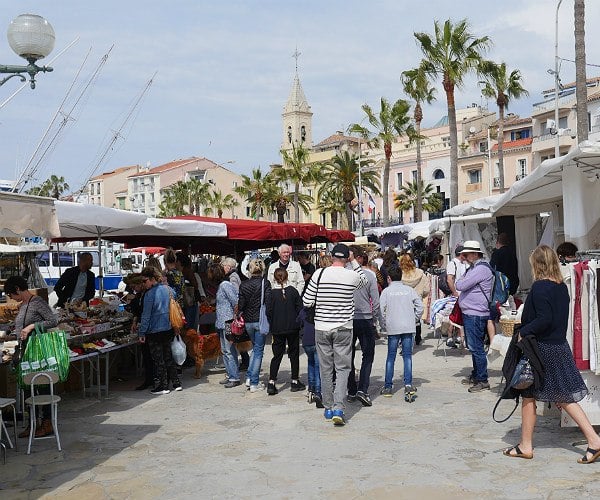 Situated in the department of Var, between Marseille and Toulon, Sanary-sur-Mer has a picturesque harbourside setting, and fought off tough competition from Royan (2nd), St. Pierre of Reunion (3rd), Uzès (4th), Arras (5th), Châtillon-sur-Chalaronne (6th), Issigeac (7th), Dieppe (8th), Puy-en-Velay (9th) and Valves (10th) to be crowned the most beautiful market in France.
Situated in the department of Var, between Marseille and Toulon, Sanary-sur-Mer has a picturesque harbourside setting, and fought off tough competition from Royan (2nd), St. Pierre of Reunion (3rd), Uzès (4th), Arras (5th), Châtillon-sur-Chalaronne (6th), Issigeac (7th), Dieppe (8th), Puy-en-Velay (9th) and Valves (10th) to be crowned the most beautiful market in France.
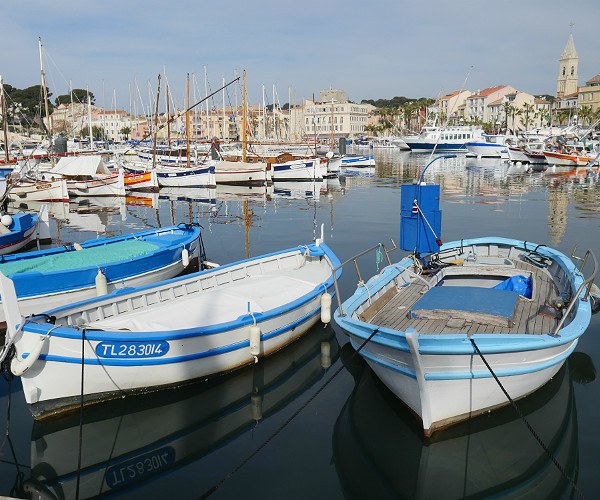 Wednesdays are a great day for fish at the market with many stalls lining the harbour, displaying recent catches – some quite large – right by the water’s edge. Even if you have no intention of buying, it’s fun just to watch the hive of activity as fishermen cut a whole tuna into steaks ready for sale or chat to passing customers.
Wednesdays are a great day for fish at the market with many stalls lining the harbour, displaying recent catches – some quite large – right by the water’s edge. Even if you have no intention of buying, it’s fun just to watch the hive of activity as fishermen cut a whole tuna into steaks ready for sale or chat to passing customers.
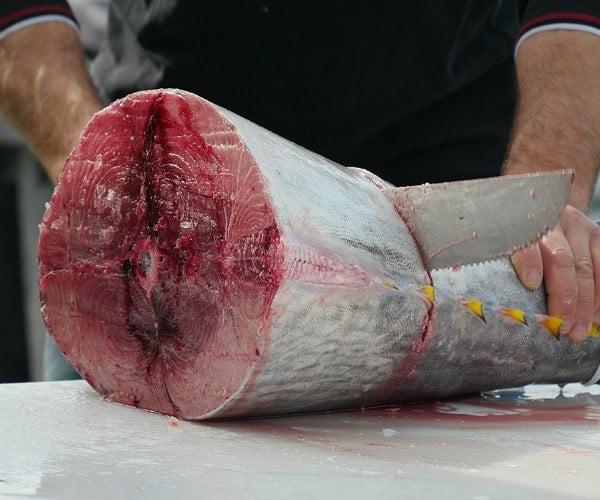
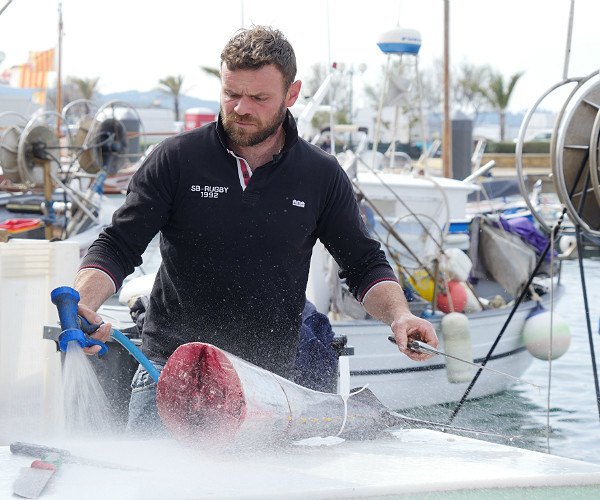 Just a stone’s throw from here, a specialist horse meat van sold a variety of different cuts. Given the anatomical similarities to a cow, these cuts are much the same as you would find in beef, but typically with less fat. Finer cuts such as tenderloin, sirloin and entrecote were all displayed, along with a number of cheaper cuts more suited to slower cooking and for use in casseroles, for example.
Just a stone’s throw from here, a specialist horse meat van sold a variety of different cuts. Given the anatomical similarities to a cow, these cuts are much the same as you would find in beef, but typically with less fat. Finer cuts such as tenderloin, sirloin and entrecote were all displayed, along with a number of cheaper cuts more suited to slower cooking and for use in casseroles, for example.
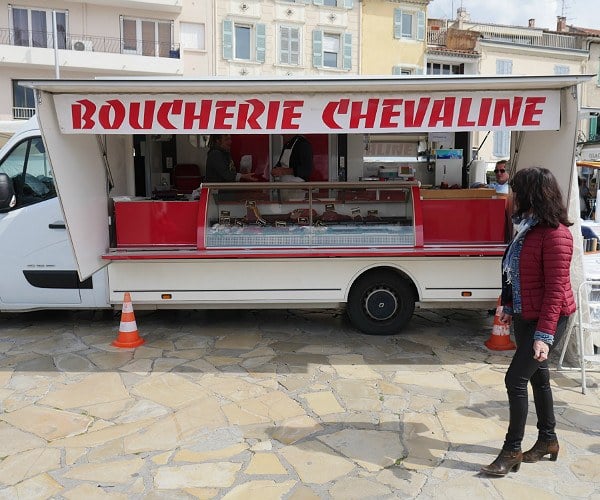 There are also stalls cooking dishes in what I would call large paella pans but no doubt they have a different name in France!
There are also stalls cooking dishes in what I would call large paella pans but no doubt they have a different name in France!
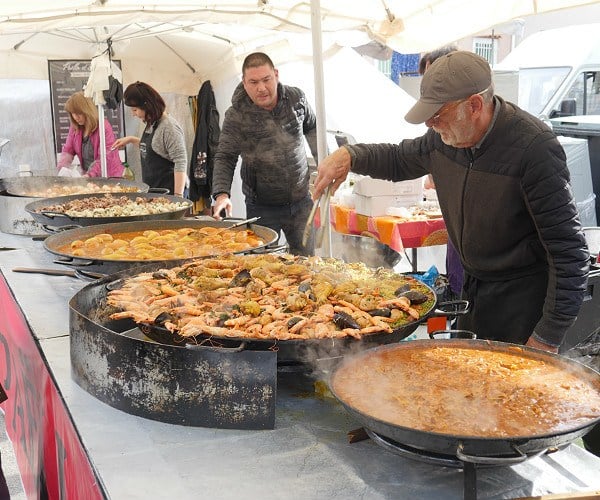
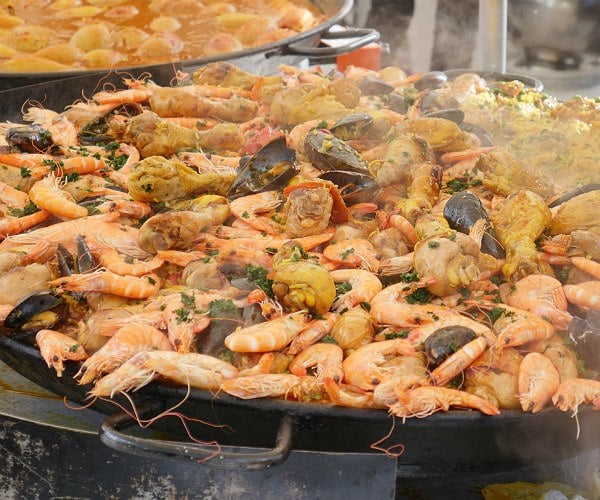
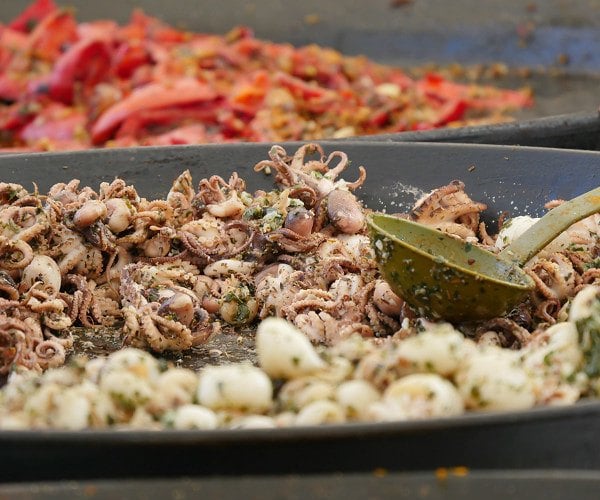 I visited with the owner of the new small luxury hotel Mas du Brulat, Su Stephens, and consultant chef for the hotel’s L’Olivier restaurant, Clive Dixon, who himself has worked alongside the likes of Heston Blumenthal and Pierre Koffmann, on a quest to find some of the region’s best local produce for the restaurant and some ingredients that Clive would use to prepare a meal for us later that evening.
The emphasis was on finding quality produce and creating a meal from that, rather than coming up with a dish first and then trying to source the required ingredients – a subtle but important difference that prioritises quality produce ahead of a pre-determined menu. And finding great produce at a French market is made easier because many of the stalls allow you to sample and taste their offerings, and you can also talk directly to the producers.
One of our first stops was at the cheese stall run by Nos Fromages de France.
I visited with the owner of the new small luxury hotel Mas du Brulat, Su Stephens, and consultant chef for the hotel’s L’Olivier restaurant, Clive Dixon, who himself has worked alongside the likes of Heston Blumenthal and Pierre Koffmann, on a quest to find some of the region’s best local produce for the restaurant and some ingredients that Clive would use to prepare a meal for us later that evening.
The emphasis was on finding quality produce and creating a meal from that, rather than coming up with a dish first and then trying to source the required ingredients – a subtle but important difference that prioritises quality produce ahead of a pre-determined menu. And finding great produce at a French market is made easier because many of the stalls allow you to sample and taste their offerings, and you can also talk directly to the producers.
One of our first stops was at the cheese stall run by Nos Fromages de France.
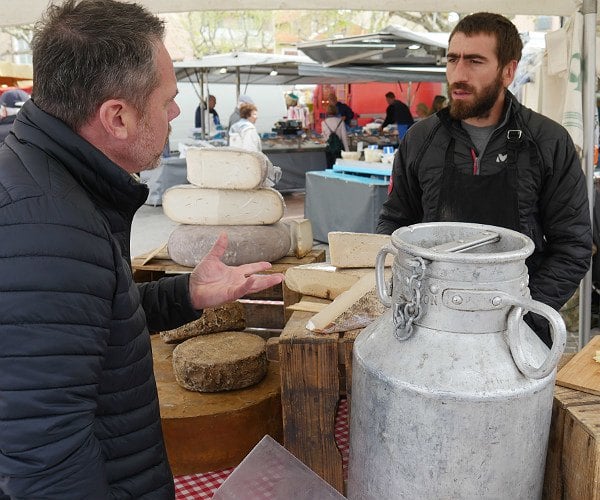 There Clive was drawn to a mature goat’s cheese from the Savoie region of France that had the crumbly consistency of a Parmesan but with a delicious, nutty flavour.
There Clive was drawn to a mature goat’s cheese from the Savoie region of France that had the crumbly consistency of a Parmesan but with a delicious, nutty flavour.
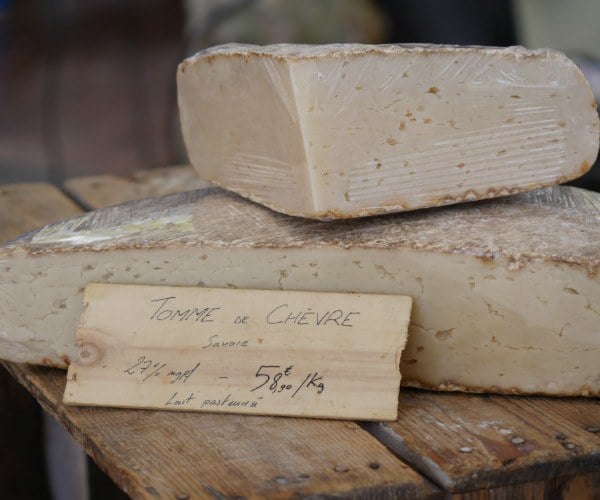 Next up the grocery stall run by Fred et Karin, a family business from Ollioules.
Next up the grocery stall run by Fred et Karin, a family business from Ollioules.
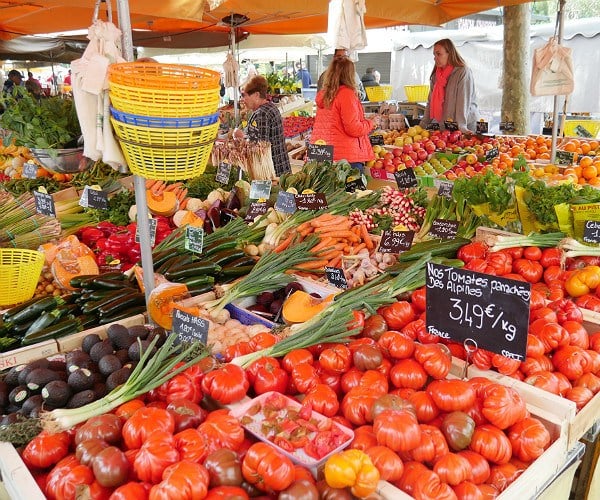 There they had some particularly good tomatoes that you could taste and we ended up coming away with two different varieties that would go nicely with the goat’s cheese for a simple starter.
There they had some particularly good tomatoes that you could taste and we ended up coming away with two different varieties that would go nicely with the goat’s cheese for a simple starter.
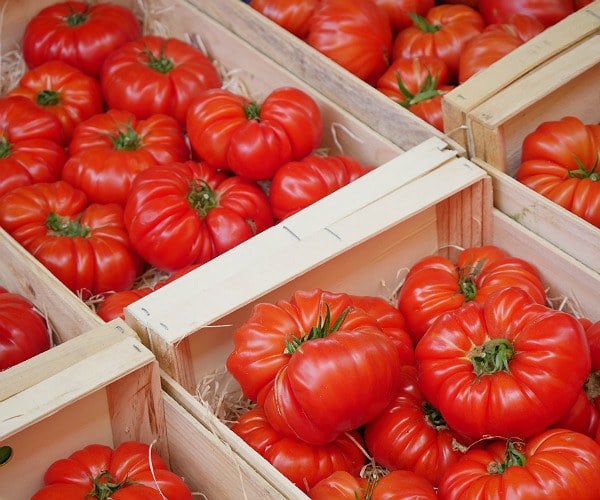 We had seen both white and green varieties of asparagus in abundance at a number of stalls so it was clearly something that was in season. We opted for the slightly more delicately-flavoured white asparagus to go with some fish that we’d be having for our main course.
We had seen both white and green varieties of asparagus in abundance at a number of stalls so it was clearly something that was in season. We opted for the slightly more delicately-flavoured white asparagus to go with some fish that we’d be having for our main course.
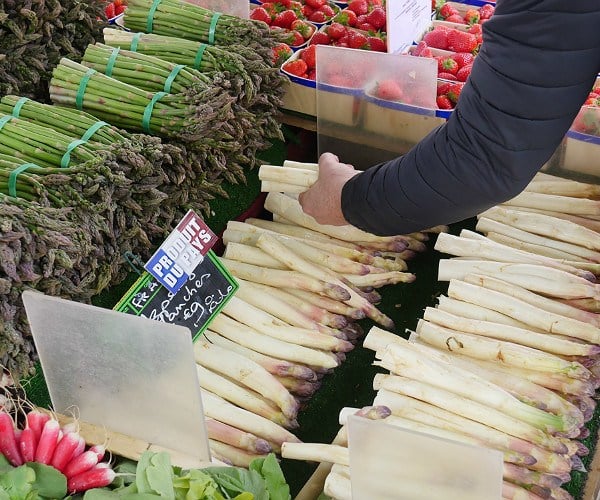 Clive had had his eye on some Gariguette strawberries but, after we tasted the Carpentras variety which is famed for its early crop in Provence, it really was no contest. Displayed with them was a Qualisud certificate for their exceptional quality. And they really did taste amazing!
Clive had had his eye on some Gariguette strawberries but, after we tasted the Carpentras variety which is famed for its early crop in Provence, it really was no contest. Displayed with them was a Qualisud certificate for their exceptional quality. And they really did taste amazing!
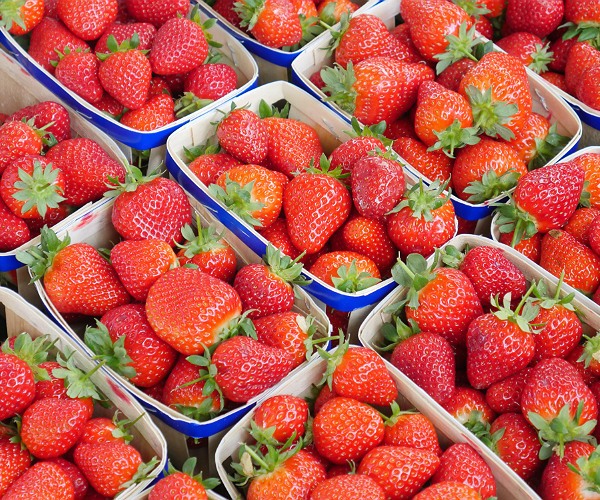 Next it was on to the fish stand belonging to Poissonnerie Pilato, the commerical division of which also already supplies the hotel’s L’Olivier restaurant.
Next it was on to the fish stand belonging to Poissonnerie Pilato, the commerical division of which also already supplies the hotel’s L’Olivier restaurant.
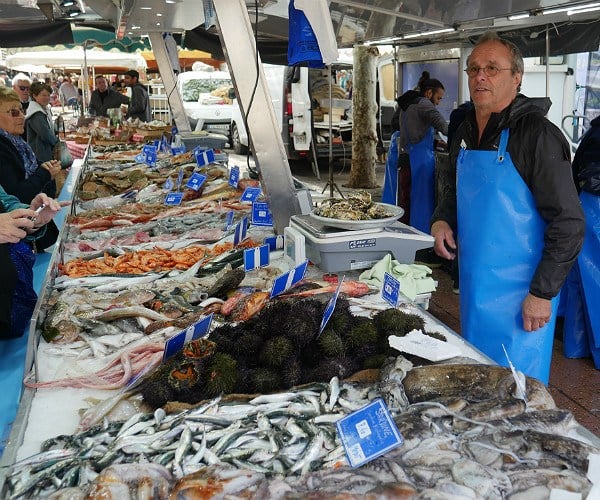 Here we bought some monk fish…
Here we bought some monk fish…
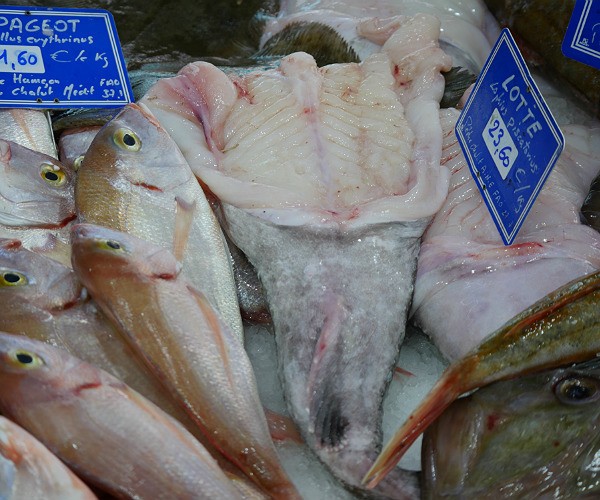 …and some red mullet.
…and some red mullet.
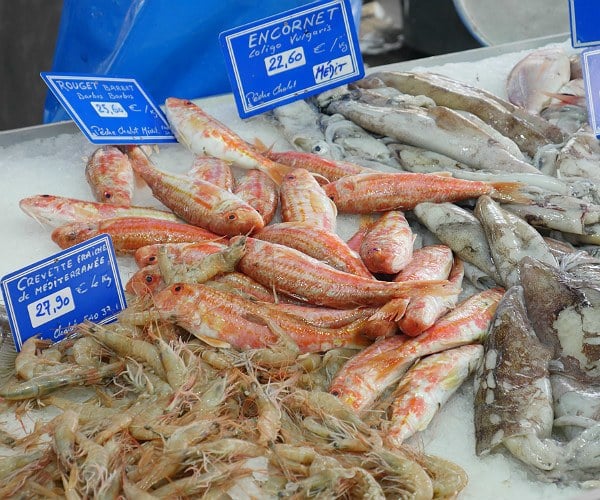 Even if you have no interest in purchasing, it’s worth watching what goes on at the stall – the staff are quite entertaining and jovial, doing silly things like kissing the fish and pretending they are flying, as well as getting on with the more serious business of de-scaling and gutting anything you buy, should you wish.
Even if you have no interest in purchasing, it’s worth watching what goes on at the stall – the staff are quite entertaining and jovial, doing silly things like kissing the fish and pretending they are flying, as well as getting on with the more serious business of de-scaling and gutting anything you buy, should you wish.
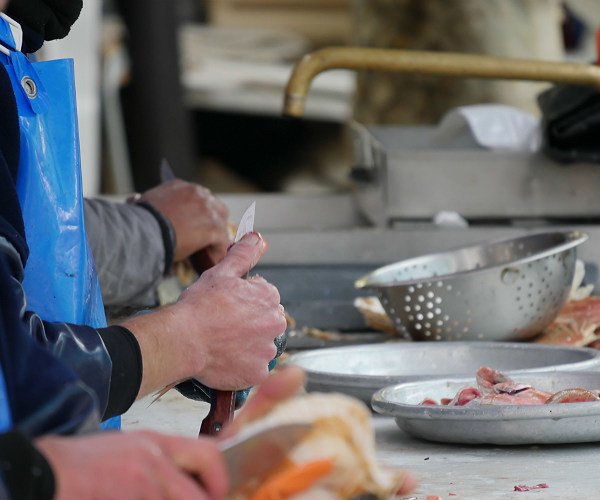 Whilst doing the rounds at the market, we also sampled some meats at Le Roi de la Bistouquette’s stall, where they had a particularly tasty Figatelli – a Corsican specialty – amongst other meats.
Whilst doing the rounds at the market, we also sampled some meats at Le Roi de la Bistouquette’s stall, where they had a particularly tasty Figatelli – a Corsican specialty – amongst other meats.
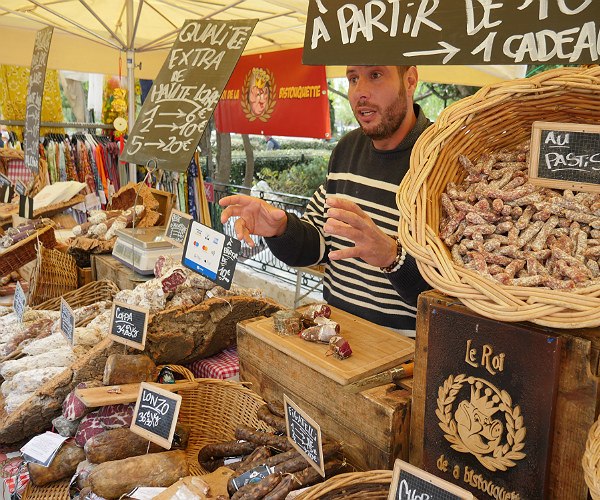 There are plans back at the hotel to develop the cellars with an exciting and lively wine bar and many of these meats would be ideal for some lovely charcuterie plates, so this was a useful find for the future.
There are plans back at the hotel to develop the cellars with an exciting and lively wine bar and many of these meats would be ideal for some lovely charcuterie plates, so this was a useful find for the future.
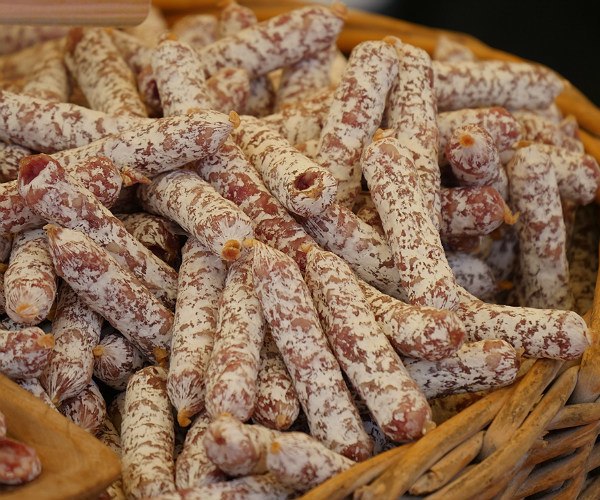 Of course, there are many other stalls at the market – not just more food stalls with things like bread, olives and much more, but also stalls with items such as clothes, kids’ toys and so on, but to my mind it’s the food at the market that’s by far the most interesting. Once we had our fill of the market (quite literally in some ways!), we headed for a patisserie to purchase a tarte tropézienne.
Of course, there are many other stalls at the market – not just more food stalls with things like bread, olives and much more, but also stalls with items such as clothes, kids’ toys and so on, but to my mind it’s the food at the market that’s by far the most interesting. Once we had our fill of the market (quite literally in some ways!), we headed for a patisserie to purchase a tarte tropézienne.
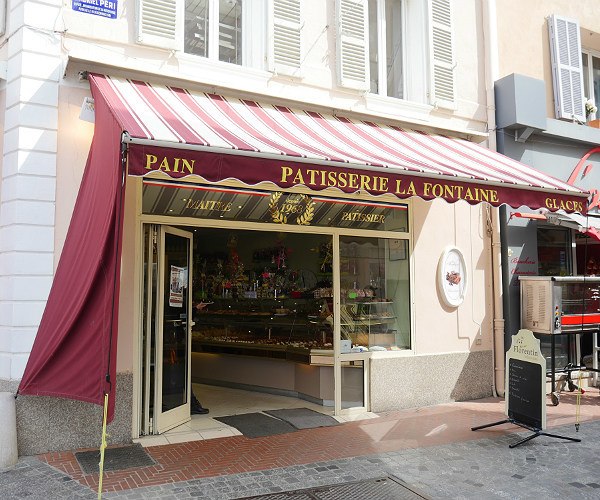 As its name suggests, tarte tropézienne has its origins in St. Tropez but was in fact given its name by none other than the then relatively unknown Brigitte Bardot when she was in the city for the film ‘And God Created Woman’ which was largely responsible for bringing her into the public spotlight. As it’s name doesn’t suggest, it is more of a cake than a tart; it was invented by Alexandre Micka, a Polish pastry chef in St Tropez, and consists of a round brioche with pearl sugar and a sort of pastry cream and buttercream filling, with a delicate flavour of orange blossom water.
As its name suggests, tarte tropézienne has its origins in St. Tropez but was in fact given its name by none other than the then relatively unknown Brigitte Bardot when she was in the city for the film ‘And God Created Woman’ which was largely responsible for bringing her into the public spotlight. As it’s name doesn’t suggest, it is more of a cake than a tart; it was invented by Alexandre Micka, a Polish pastry chef in St Tropez, and consists of a round brioche with pearl sugar and a sort of pastry cream and buttercream filling, with a delicate flavour of orange blossom water.
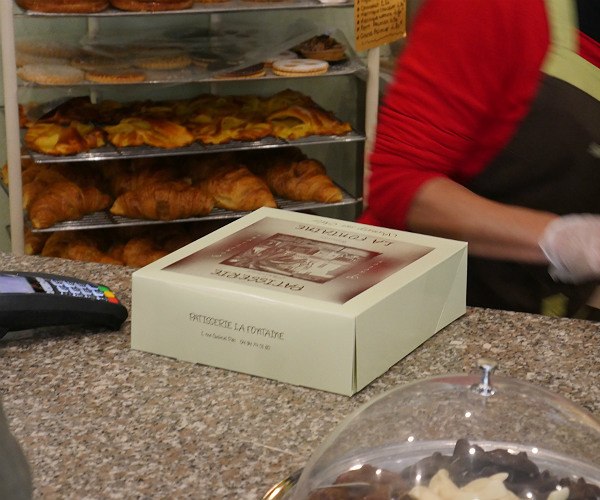 Finally, a wander around Sanary-sur-Mer’s streets, away from the hustle and bustle of the market, was a good way to get more of a feel for this pretty town. Explorer Jacques Cousteau had a home here and it was in the waters off Sanary that he developed diving equipment that is still crucial to deep-sea diving today. There’s even a museum – the Frédéric Dumas International Diving Museum – in the town, dedicated to the man who achieved a world-record deep-sea dive in 1943.
Finally, a wander around Sanary-sur-Mer’s streets, away from the hustle and bustle of the market, was a good way to get more of a feel for this pretty town. Explorer Jacques Cousteau had a home here and it was in the waters off Sanary that he developed diving equipment that is still crucial to deep-sea diving today. There’s even a museum – the Frédéric Dumas International Diving Museum – in the town, dedicated to the man who achieved a world-record deep-sea dive in 1943.
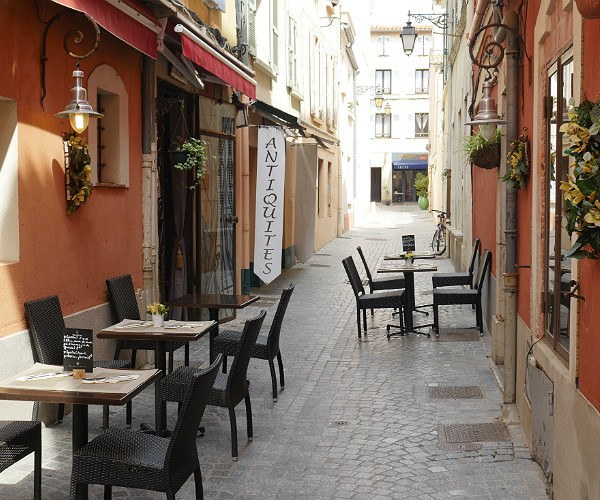 Back at L’Olivier, Clive worked his magic in the kitchen. The starter was relatively simple (so often the simplest dishes are the best, though!) and involved combining the tomatoes with the cheese, some basil, olive oil, seasoning (both smoked Maldon sea salt and Camargue salt), and a dash of sherry vinegar, so the focus of his attention soon turned to our main course.
Having peeled the bottom two thirds of the asparagus (white asparagus spears tend to be thicker and more fibrous than their green counterparts), they were put in a pan with some butter, olive oil and a little water, and some roasted garlic later, and then set aside whilst the fish was cooked.
Back at L’Olivier, Clive worked his magic in the kitchen. The starter was relatively simple (so often the simplest dishes are the best, though!) and involved combining the tomatoes with the cheese, some basil, olive oil, seasoning (both smoked Maldon sea salt and Camargue salt), and a dash of sherry vinegar, so the focus of his attention soon turned to our main course.
Having peeled the bottom two thirds of the asparagus (white asparagus spears tend to be thicker and more fibrous than their green counterparts), they were put in a pan with some butter, olive oil and a little water, and some roasted garlic later, and then set aside whilst the fish was cooked.
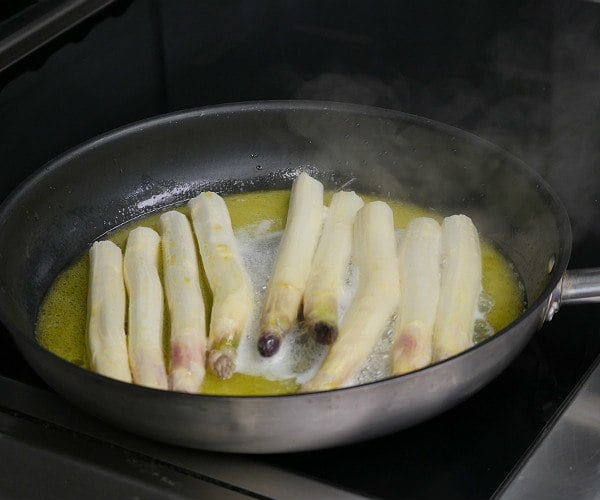 The red mullet had the heads and tails removed and was de-boned…
The red mullet had the heads and tails removed and was de-boned…
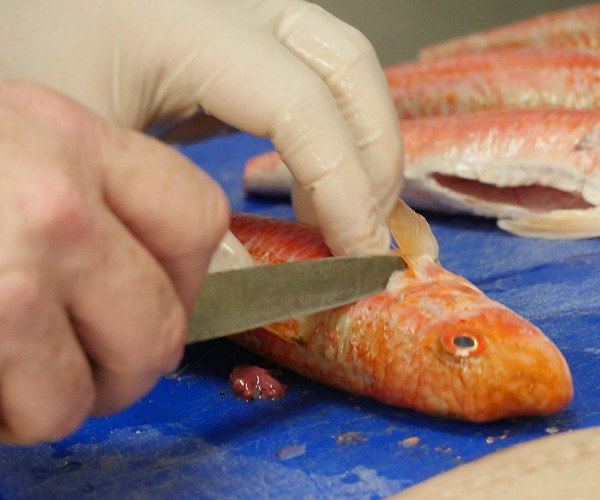 …before being cooked on a low heat with some white wine, olive oil and a little rosemary, with the pan covered with some clingfilm to help keep the moisture in. (Yes, you can do this if the heat is low enough!)
…before being cooked on a low heat with some white wine, olive oil and a little rosemary, with the pan covered with some clingfilm to help keep the moisture in. (Yes, you can do this if the heat is low enough!)
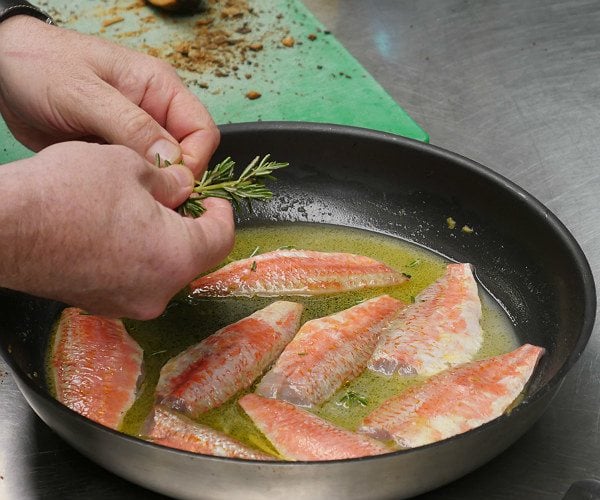 The monk fish was seasoned and cooked sous vide (vacuum packed and cooked at a low temperature in water) before being finished in the same pan that had been used for the asparagus and basted regularly with the juices.
The monk fish was seasoned and cooked sous vide (vacuum packed and cooked at a low temperature in water) before being finished in the same pan that had been used for the asparagus and basted regularly with the juices.

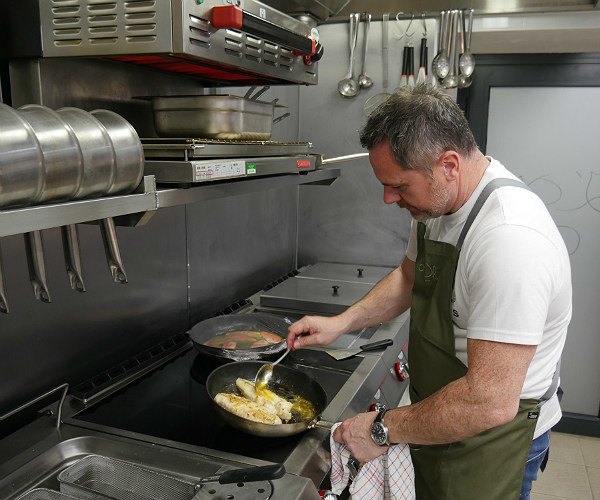 Dessert consisted of the tarte tropézienne which was served with the strawberries that were washed and hulled, as well as a basil ice cream which Clive had prepared earlier but that was freshly churned using a Pacojet.
Dessert consisted of the tarte tropézienne which was served with the strawberries that were washed and hulled, as well as a basil ice cream which Clive had prepared earlier but that was freshly churned using a Pacojet.
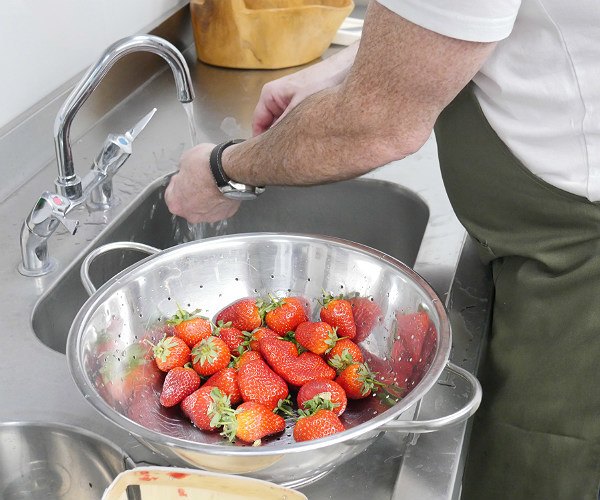 As for the finished product? Here are the three dishes that we had… and rest assured, they tasted every bit as good as they look!
As for the finished product? Here are the three dishes that we had… and rest assured, they tasted every bit as good as they look!
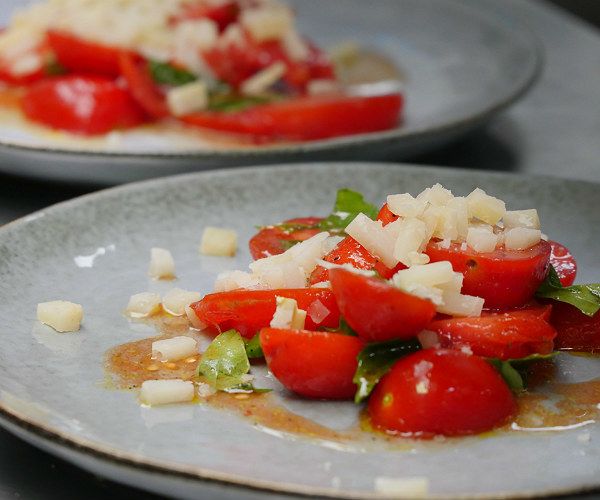
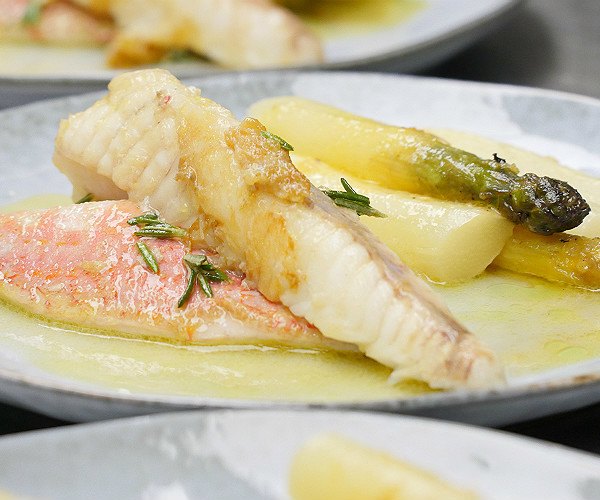
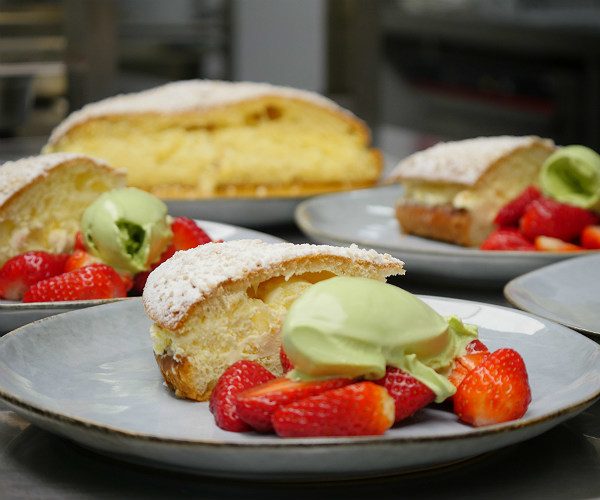 Disclosure: Our trip to the South of France was courtesy of Mas du Brulat, a small luxury hotel in Le Castellet commune of Provence – part of the Olives & Vines brand.
Disclosure: Our trip to the South of France was courtesy of Mas du Brulat, a small luxury hotel in Le Castellet commune of Provence – part of the Olives & Vines brand.Did you enjoy this article?
Receive similar content direct to your inbox.


There are many exquisite markets in France so to say that the market at Sanary-sur-Mer is the most beautiful is a big, big call. Reading through your piece and looking at some great photos you do put together a pretty convincing case. I think I’ll just have to visit it to judge it for myself.
It’s not just me making the case for it – it was the viewers of the “Votre Plus Beau Marché” competition run by TF1 which was hugely popular with voters. The first round alone gathered around 400,000 votes!
Still, you might want to go along just to check… ;-)
How do they decide which is the most beautiful market? I’d be fascinated to learn what criteria people use to judge “beauty”?
You could have a good looking market in a pretty village but without a great range of products. How would that rate?
I don’t know exactly as I didn’t watch the program, but I guess it’s a case of ‘beauty is in the eye of the beholder’… so whatever you personally deem to be beautiful, perhaps? I’m sure a pretty village without a good range of products isn’t really going to get a look-in, though, given the wealth of great markets that are to be found in France.
Depending on what your French is like, you can see the website for the programme here: https://votreplusbeaumarche.fr/
There’s also a video you might like to view here:
https://www.lci.fr/regions/votre-plus-beau-marche-sanary-sur-mer-fete-le-premier-anniversaire-de-sa-victoire-2120755.html
Sanary-sur-Mer wasn’t a place I’d heard of before so this was fascinating. Good tips on when would be best to visit, that’s always handy to know. There’s so much variety to be had here, and it sounds really warm and friendly with being able to taste samples and talk to producers on a lot of the stall. The tarte tropézienne sounds like an interesting choice. My mouth is watering! xx
Yes, the stall-holders were all very friendly, keen for you to try their produce, with lots of samples on offer!
I have visited a number of French markets but my problem is that I never seem to get past the cheese stalls. I love tasting and trying to talk to the cheese makers in my appalling French. They offer such a great range of cheeses.
Yes, and they had some really interesting cheeses at Sanary-sur-Mer… even some blue cheeses that I think had been aged for a couple of years. I must say, they didn’t look so appetising, but I’m sure they were probably very good!!
A long time ago I learnt never to stay in a hotel in the French countryside. You find all of these fantastic markets but if you are getting your meals at the hotel it is so frustrating. You see all this fantastic produce and you can only buy little bits to try.
For the last 8 of 9 years so have always booked a gite so that we can go shopping for our lunch and dinner. It’s all part of the experience of being French for a few weeks.
Don’t forget that many of the restaurants will get their produce from these markets, too.
Also, if you do prefer to select your own and return home to cook it, Mas du Brulat also have their own luxury self-catering property on the edge of Le Brulat, called Mas des Avelines, that sleeps 10 people.
I tend to have a summer holiday in Provence every few years. I had never been to Sanary-sur-Mer. After reading this I’ll definitely drop in to the market on my next trip to France.
Provence-Alpes-Côte d’Azur covers such a large area (over 30,000 sq km, I think) that it would not surprise me if even regular visitors continue to discover new places. I hope you enjoy Sanary-sur-Mer on your next visit, Ted..!
I hope that this award doesn’t change the market at Sanary-sur-Mer. Sometimes a flood of visitors can be a problem. You might find that the market starts catering for tourists, for instance selling souvenirs rather than the local produce it is famous for. It would be sad if it became crowded and difficult to walk through.
I hope not, too. It didn’t feel that way and walking around was no problem at all. Yes, there were some tourists there… but a good mix of local people also. In fact, I got the feeling that it was far more locals than tourists, and the market itself still felt very traditional and typically French. I don’t really recall seeing any souvenir stalls.
Really, its a very beautiful place.I think I want to visit this place in future.
I hope you manage to get there one day soon, Ravi!
I think these markets are one of the reasons why the French enjoy such a high quality of cuisine. When you’ve got to sell your produce from a stall with competing stalls all around you it is bound to drive up the quality.
Yes, the markets do seem to have a strong focus on quality produce. I don’t know how the French do it, but I find it very different in the UK. Maybe it has more to do with French culture and a focus on quality food and ingredients. Despite there being lots of large supermarkets in France, just like in the UK, the markets still seem to thrive.
And don’t forget that the stall-holders get to talk to the customers. They find out what they want so it is a great listening device too.
Yes, very true, Peter!
A long, long time ago I had to “study” in France as part of my degree. At the time I thought the markets were fantastic. Of course I still visit France, often Provence, and nowadays there’s a far greater variety of goods than back then. Also, generally speaking I think the quality’s better too.
That’s interesting to hear, Judy, as I thought the markets had always been a very strong part of French life. I remember visiting them as a child and seeing more live produce back then – ducks, frogs, etc. – but I just don’t see that nowadays, presumably because it is frowned upon and not fair to the animals.
Sadly I didn’t get to the market at Sanary-Sur-Mer but I am just back from the South of France and a stroll around the local market. I hadn’t visited for a few years and it was encouraging to see that the market is in really good shape, there was a lot more variety, one of the locals said that one market recently had 30 different species of tomato on sale. There were even a few items that I didn’t recognise. Surely such diversity can only be a good thing?
Definitely, Sunil… and another nice thing is that you can taste so much of the produce, including things like tomatoes, strawberries, sausages, cheeses, etc. In fact, you could very easily have a very satisfying lunch by just wandering around!!
I hope that the locals appreciate what they have got with such an impressive and vibrant market. It’s all too easy to be tempted away by the convenience of one-stop shops in the supermarkets with their lower prices. But ultimately those advantages come at the cost of choice and quality.
I do think this is something the French value perhaps more so than we do in the UK. The market was busy (but not unbearably busy, thankfully) for the whole time we were there, and mostly with locals rather than tourists I would say.
Oh for a market like Sanary-sur-Mer or any market in the South of France! I’ve just been to my local English market on a blustery, drizzly and grey Saturday morning. Even though it is supposedly June the traders looked bored and frozen. The produce just didn’t look very inspiring at all. A lot of the fruit and veg had clearly been forced in green houses and looked very artificial.
Sorry to hear that, Janet! I do like to support our local market here in Kendal (the first market charter was given to the town in 1189) from time to time, but I would have to say it was not a patch on this one at Sanary-sur-Mer, sadly. We do have a monthly farmers market as well, but again it’s just not the same…
Nowadays we hear business people, economists and politicians talking a lot about markets. And what is the Brexit debate if not a discussion of which markets Britain will trade in?
But there’s a glorious simplicity to this French market which reminds us all of the beautiful origins of the market. People gathering together to buy and sell the best fares that they have.
Thanks for dropping by to comment, Roger. Yes, I think it should be noted that these markets doing really have great quality produce when it comes to food.
I must remember to pack the shopping bags on my next holiday in the South of France. I get a bit carried away when I see a market like this and my partner ends up carrying loads of bags.
I must admit, I didn’t especially look at the non-food produce that was for sale much, but I’m sure you’d probably find some interest there also. Markets like these, I think, are best for the food produce – it would be an excellent resource if you were staying in self-catering accommodation and wanted to find good quality ingredients to cook back at your accommodation.
Here in Britain we are making some progress with markets. But I do question whether these once a month markets work. For the rest of the month people slip back into their supermarket shopping routine. If you are pressed for time one-stop shopping can be all too appealing, And as we only know too well we are all pressed for time nowadays.
That’s a good point, Tony. The town where I live in the UK has a weekly market (it’s had its own market charter since 1189 – the time of Richard I), but the farmers market – where I feel the real interest lies when it comes to produce – is sadly only a monthly affair. Maybe with greater regularity it might have a chance to compete with the supermarkets more.
Heading south down the French autoroutes for the annual August two weeks in the sun soon. Yes, it’s that battered old Volvo, with a GB sticker, paying a Euro fortune at the peages and holding everyone up. Never been to Sanary-sur-Mer but if everyone thinks that it is the most beautiful market in France then we’ll plug it into the sat nav this summer and give it a go.
Hope you managed to get there, Vernon, and enjoy it as much as we did!
I’ve just watched the film “The 100 foot Journey” on Netflix. Some of the scenes were filmed in a French Market, with unbelievable glossy fruit and veg.It reminded me of this piece.
Early in the film, the Indian chef who was the real hero of the film complained that English vegetables had “no soul”. Once he started tasting French produce in the south of France it was a very different story.
Interesting. Sunlight gives fruit and veg when it comes to nutrients and flavour, so it would not surprise me if produce from the South of France is more flavourful than its UK equivalents.
I can spend hours just browsing around a market. Must track this one down next time that I’m in the South of France.
Yes, make sure you do, Grace… it’s a real gem!
I love markets like this! I always visit our local weekend markets so I can buy fresh produce and artisanal products. However, since this lockdown happened many turned online to sell their products. It’s not the same as touching the items and being able to swap stories with the vendors. Still, I am glad that all my favourite produce and merch are still available for me to enjoy.
You make a good point, Kristine. Being able to speak to the vendors gives it that extra special touch. You can actually learn so much more about the food you’re putting on your plate by understanding precisely where it’s come from.
I can see why this would be the most beautiful market, just look at the variety of produce you can get. And the backdrop of the Grand Marche is fantastic. Being close to the sea is a plus as well because access to fresh seafood is guaranteed.